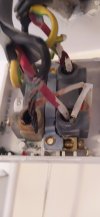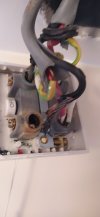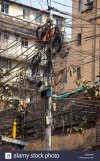willin
DW Regular
- Joined
- Sep 17, 2007
- Messages
- 729
- Reaction score
- 369
I wonder if anyone can help/advise, I have a Triton T70GSI 10.5Kw (herein could lie the problem – 10.5Kw) shower, It’s wired to a B40 MCB (Crabtree) 40A miniature circuit breaker in the consumer unit. And a 50A ceiling isolator switch.
The house is around 22 Y O so I would think it’s been done somewhere near todays wiring specs, after around 6 – 8 years I had to replace the ceiling switch as it stopped working I did notice it was a little brittle and had been getting hot (by the looks). Same again after around the same amount of time but the wiring insulating was looking discolored (from heat), I ignored it when I probably should have had it checked out, lately the shower refused to switch on so I checked the shower solenoid/feed etc with a multimeter, all fine. took the switch off and found this (see pictures).
Doing a google search on this apparently it’s a fairly common problem, I had a 45a switch so have put that on temporary and I’m switching the supply off by the consumer unit for now.
My thoughts are to strip the wiring back a little and fit a 50a switch, crabtree seems to be the recommended switch, can any electrician/anyone offer any advice? Does any of the wiring/switches need something different?


The house is around 22 Y O so I would think it’s been done somewhere near todays wiring specs, after around 6 – 8 years I had to replace the ceiling switch as it stopped working I did notice it was a little brittle and had been getting hot (by the looks). Same again after around the same amount of time but the wiring insulating was looking discolored (from heat), I ignored it when I probably should have had it checked out, lately the shower refused to switch on so I checked the shower solenoid/feed etc with a multimeter, all fine. took the switch off and found this (see pictures).
Doing a google search on this apparently it’s a fairly common problem, I had a 45a switch so have put that on temporary and I’m switching the supply off by the consumer unit for now.
My thoughts are to strip the wiring back a little and fit a 50a switch, crabtree seems to be the recommended switch, can any electrician/anyone offer any advice? Does any of the wiring/switches need something different?



